Announced at Photokina last year alongside Canon’s first full-frame mirrorless camera, the EOS R, the Canon RF 28-70mm F2.0 L USM is the world’s fastest 28-70mm zoom lens.
As a large-aperture zoom, it has a complex construction, with 19 elements in 13 groups, two of which are ultra-low dispersion (UD) and one a Super UD to further reduce fringing. In addition, to control the effects of astigmatism and distortion, the lens has four elements with aspheric surfaces. As a top-tier Canon L-series model, it has SWC (sub-wavelength) and ASC (air sphere) coatings to help reduce flare and ghosting, while the front and rear elements have a fluorine coating to facilitate cleaning.
Internal focusing uses a quiet but powerful high-speed ring-type USM, and has a minimum focusing distance of 0.39m (1.28 ft). The lens features nine rounded aperture blades to improve the attractiveness of out-of-focus highlights—a particular benefit when used for portraiture and wedding photography.
Externally, there’s a wide rubber zoom ring, along with a knurled control ring at the front for aperture selection, but it can be used for setting shutter speed, ISO, or exposure compensation. Measuring 139.8 mm x 103.8 mm (5.5 x 4.09 in.) and weighing 1430 grams (3.15 lbs), the Canon RF 28-70 F2.0 L USM is aimed at high-end amateurs and professionals.
Key specifications:
- Full-frame format
- Available in RF-mount only
- Aperture range F2–F22
- 95mm filter thread
- Minimum focus distance: 0.39m (1.28 ft)
- Weight: 1430 grams (3.15 lbs)
Overall lens image quality
We tested the Canon RF 28-70mm F2.0 on the 30MP Canon EOS R body, where it achieved a 33-point score in our image quality rankings. Based on the optical performance of the imaging system (camera and lens), that makes it one of the best in our database.
The Canon RF 28-70mm F2.0 has consistently high sharpness throughout the zoom range, especially for a lens with such a large F2.0 aperture. It has high sharpness with low to non-existent astigmatism equivalent to 21 PMpix at F4 and F5.6.
One of the advantages of the RF mount’s short register is that the large-diameter element is closer to the sensor, which helps control aberrations, particularly towards the edges of the frame, and indeed, it has relatively low chromatic aberration for an ultra-high-speed zoom. Vignetting is inevitable, but it is well-controlled, reaching a maximum of –2EV in the corners when wide-open at 28mm through to 70mm.
With a 2.2 T-Stop rating, light transmission is another area where the lens performed well in our tests. Efficient transmission is a measure of well-controlled flare and ghosting. Consistent transmission is also useful for filmmakers, when an otherwise variable exposure level during zooming can be difficult to correct in post-production.
Image quality compared to its competitors
As a replacement for equivalent focal length primes, this versatile lens is enormously appealing. The RF 28-70mm F2.0 L USM zoom is close in optical performance to some high-end fixed focal length lenses, which goes to show just what’s possible with modern designs like this on mounts with short registers.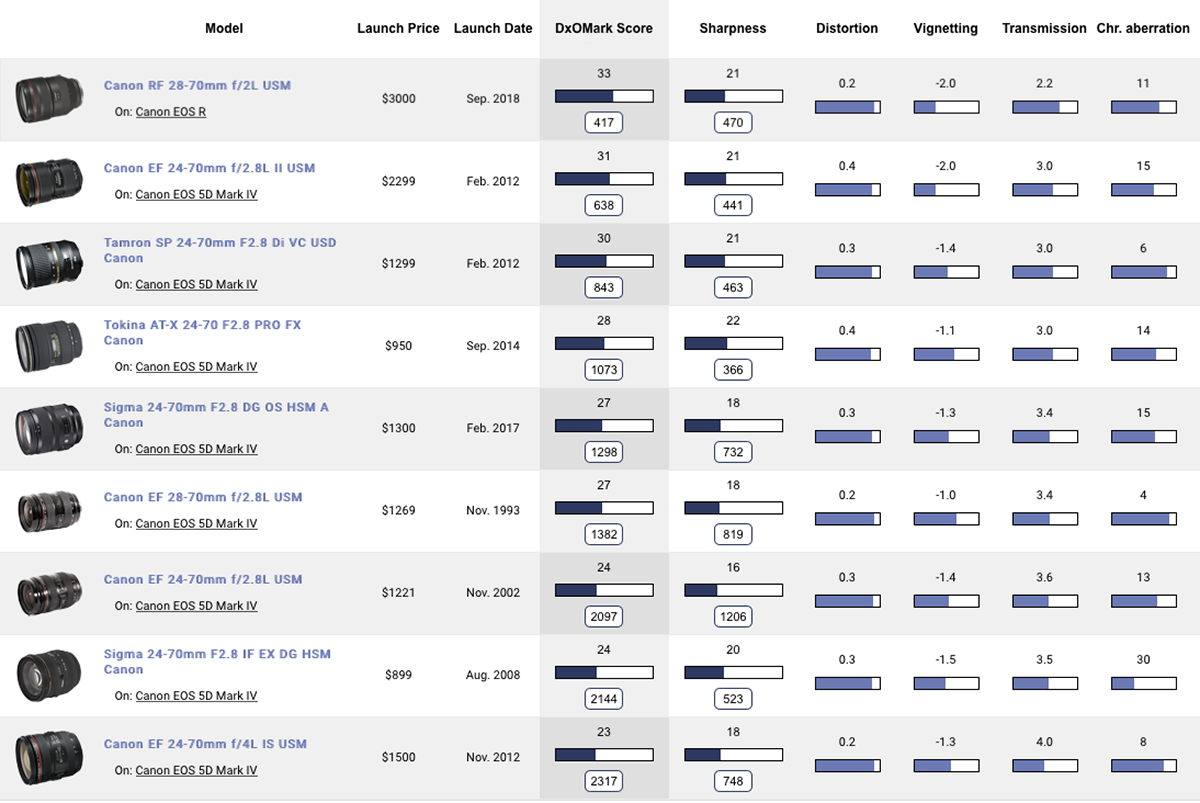
Click here to open our interactive DxOMark lens comparison tool.
However, there are a wide number of lenses from all brands that fall between 24-70mm focal length, even when using F2.0 as a maximum when filtering. So to keep the lens comparison manageable and consistent, we’re comparing the RF 28-70mm F2.0L USM on the EOS R only with native EF-mount 24-70mm lenses on the EOS 5D Mark IV. Although a DSLR, the Mark IV has a similar 30MP CMOS sensor to that used in the Canon EOS R.
This new wide-aperture zoom on the EOS R is better than the highly-regarded Canon EF 24-70mm F2.8L II USM on a Canon EOS 5D Mark IV, with more consistent sharpness when measured horizontally and vertically across the frame, indicating minimal astigmatism and something you’d be more likely to find in a highly-corrected prime.
While the new zoom lens also has low levels of geometric distortion and chromatic aberration, especially given the challenging F2.0 constant aperture, it doesn’t have that shorter 24mm focal length. That short length will likely add more distortion and chromatic aberration to a system, so it’s something to bear in mind when comparing lenses. Another area where the new zoom is to be praised is in its excellent transmission despite the high number of elements used in the construction.
Although we don’t show any primes in this comparison, you can view them using our interactive DxOMark lens ranking tool here.
In-depth comparisons
As the RF mount is Canon’s first new full-frame mount since 1987, there are few lenses with native mounts to directly compare it to. This said, for a more detailed look at the RF-mount lens’s optical performance, we’ll compare it to the highly regarded Canon EF 24-70mm F2.8 L USM II introduced in 2012 and to its predecessor, the EF 24-70mm F2.8 L USM introduced some 10 years earlier in 2002.
Remember that while the results are directly comparable between them as specific camera and lens combinations or imaging systems, if you’re using the results to judge how your lens might perform on the EOS R with the Canon EF-EOS-R mount adaptor, then the results may not be strictly interchangeable. With slightly different pixel counts between them (6732 x 4488 vs. 6880 x 4544 px), there is a possibility that the sensor and filter stack in the two cameras may be stressed differently, resulting in dissimilar resolving power.
Sharpness
When it comes to sharpness, the Canon RF 28-70mm F2.0 L USM can certainly hold its own against the high-performing EF 24-70mm F2.8 L II USM, particularly at mid-focal lengths. The new RF-mount lens is actually sharper the Mark II in the corners at 35mm and 50mm focal lengths. At either end of the zoom range, the new RF zoom performs well ahead of the Mark I, but it can’t quite top the EF 24-70mm F2.8 L II USM for peak sharpness. Nevertheless, its optical performance is still noteworthy for its sharpness when measured horizontally and vertically, which indicates extremely high correction of astigmatism.
The graph below shows how all three compare at their shortest focal length, with the RF 28-70mm F2.0 L USM at F2.0 and the two EF 24-70mm F2.8 L USM versions at 24mm, F2.8.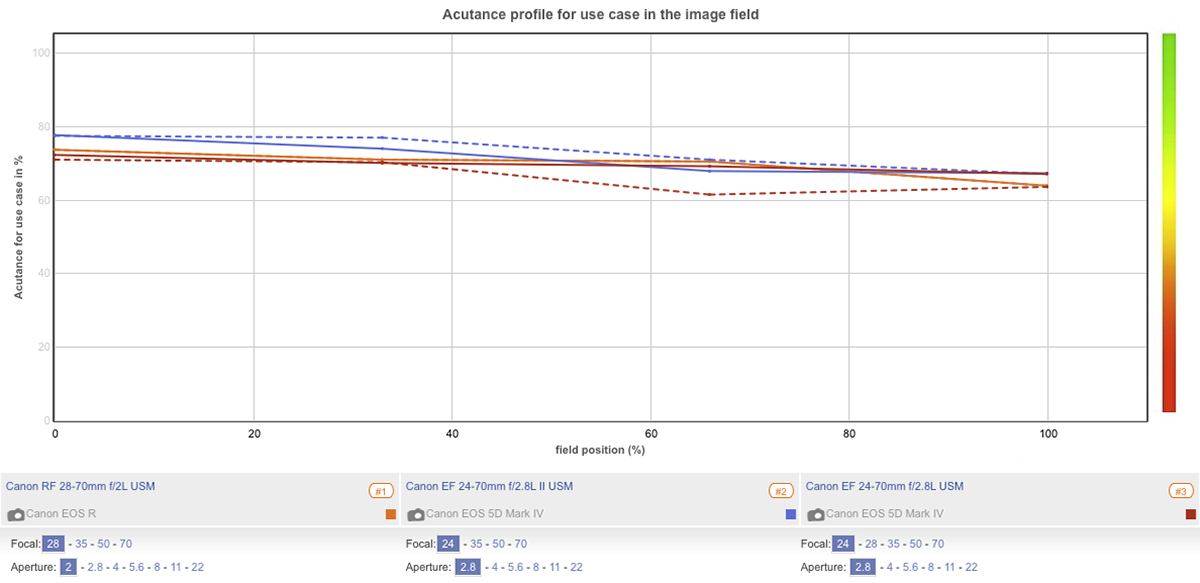
The graph below shows how all three compare at 50mm focal length, with the 28-70mm F2.0 L USM at F2.0 and the the EF 24-70mm F2.8L USM versions at F2.8.
Chromatic aberration
At its shortest focal length of 28mm, the Canon RF 28-70mm F2.0 L USM suppresses lateral chromatic aberration quite well at F2.0, but it’s mostly equal with the Canon EF 24-70mm F2.8L II USM at 24mm when wide-open.
The cross-sectional profile graph below shows the width of the colored fringing that occurs for all three lenses at their shortest focal lengths and maximum apertures, measured from the center of the frame (0% field position) to the extreme corners of the frame (at 100%).
The measurements for the Canon RF 28-70mm F2.0 L USM are shown as dark brown/blue lines and indicate excellent correction of focused light in the blue wavelength across the frame. However, it’s not as well-corrected in the red wavelength, shown below 0 on the y-axis, where fringing may be visible at around the 30% position from the center of the image out to the corners. With a fringing width of around 10 micrometers wide at the 80% position onwards, roughly covering the width of two pixels of the EOS-R’s sensor, the fringing will be much more noticeable in the corners, appearing on either side of high-contrast edges.
While it’s a similar story for the older EF-mount models, it remains quite a good result for such a fast zoom, even if it has a longer 28mm focal length at its shortest position.
Meanwhile at longer focal lengths, the new RF model has far better control of chromatic aberration than either of the older EF-mount lenses.
Geometric distortion
Moderately wide to short telephoto zooms typically have a fair amount of distortion, and it’s not really a surprise to see the Canon RF 28-70mm F2.0 L USM display barrel distortion at 28mm, turning to pincushion-shaped distortion at 70mm.
A positive value of 0.4 % at 28mm means that’s likely to be quite noticeable when there are strong linear elements, such as door or window frames or even the walls of buildings, included close to the edges of the frame.
At that focal length, distortion is higher than Canon EF 24-70mm F2.8L II USM at 28mm, but at 35mm, the RF-mount zoom still displays barrel distortion at a low 0.2%, whereas the Canon EF 24-70mm F2.8L II USM has already moved to slight pincushion, at a similarly low –0.2% level. It is unlikely to be noticed in either case, though.
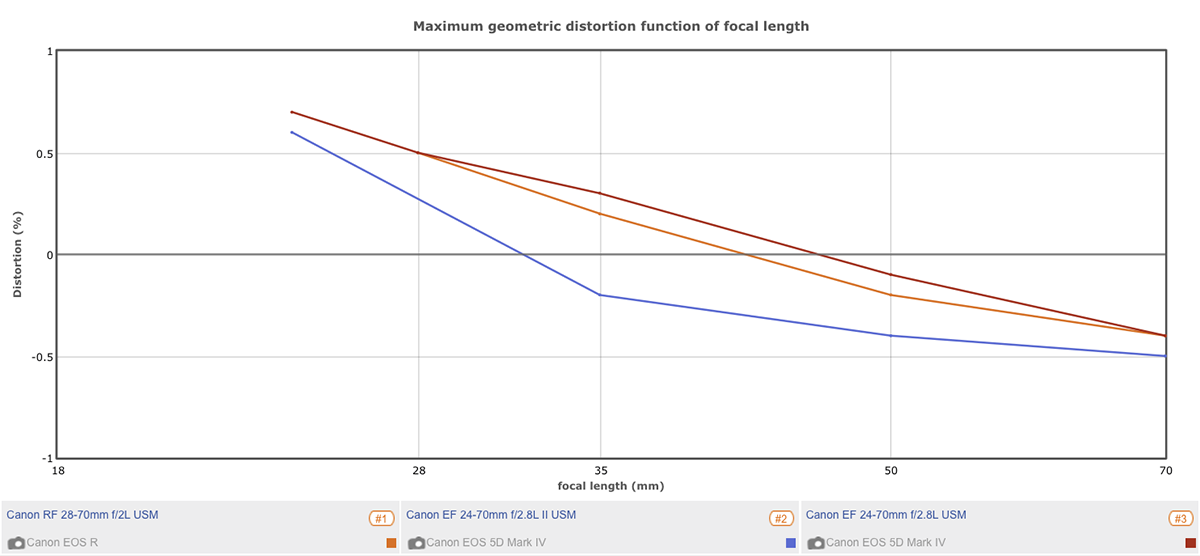
After crossing over to pincushion between 40-45mm, the RF 28-70mm F2.0 L USM measures the same –0.2% at 50mm, which is no better or worse for correction post-capture than the Canon EF 24-70mm F2.8L II USM.
Pincushion distortion continues to rise to a relatively high and noticeable –0.4% at 70mm, but that’s identical to the Canon EF 24-70mm F2.8L USM and actually lower than the later Canon EF 24-70mm F2.8L II USM.
Vignetting (corner shading)
A shorter register and the inclusion of a larger rear element still isn’t likely to make much of a difference in eliminating vignetting. However, the Canon RF 28-70mm F2.0 L USM also happens to have an exceptionally large front element and it’s that front element, perhaps in combination with the short register and larger rear element, that helps keep vignetting to well-controlled levels.
Even then, the lens still exhibits shading of up to –2EV in the corners at 28mm when wide-open. However, shading is restricted to the extreme corners, and the overall effect is one of less vignetting than the EF 24-70mm F2.8L II USM or even the older Canon EF 24-70mm F2.8L USM when wide open at 24mm.
At F2.8, the Canon RF 28-70mm F2.0 L USM has lower vignetting regardless of the focal length, and it continues to be well-behaved when stopped down, performing similarly to the EF 24-70mm F2.8L II USM. It is a good effort, but surprisingly, the older Canon EF 24-70mm F2.8L USM has the lowest levels once moved off from 28mm and stopped down two stops.
Transmission
Light transmission is a particularly important aspect of the optical performance of a lens that’s also touted for video. In this regard, the Canon RF 28-70mm F2.0 L USM performs well, with efficient and near constant transmission throughout the range of focal lengths. Transmission close to F-stop values also indicates low reflectance and that typically results in low ghosting and flare, which is important in both stills photography and video capture.
Conclusion
With such a fast F2.0 maximum aperture at all focal lengths, the new Canon RF zoom certainly feels like it’s showcasing the potential of switching to the new RF mount. Given the possibilities for low-light shooting, when switching between primes isn’t ideal, a lens like this is sorely tempting. At a dollar shy of $3,000, though, it is a pricey proposition. Still, it has very impressive optical performance, and when viewed overall, it’s even a slightly better performer than the highly-regarded Canon EF 24-70mm F2.8L II USM. Its appeal is somewhat niche, but if you need a lens like this, there isn’t anything else on the market quite like it.
In this review, we have compared the Canon RF 28-70mm F2.0 L USM to its closest rivals from the EF lens range. Remember that the lenses are intended to be used on different camera systems and mounts, so the comparisons are not strictly applicable.
As usual, you can create your own comparisons and in-depth analyses using our interactive image lens comparison tool.


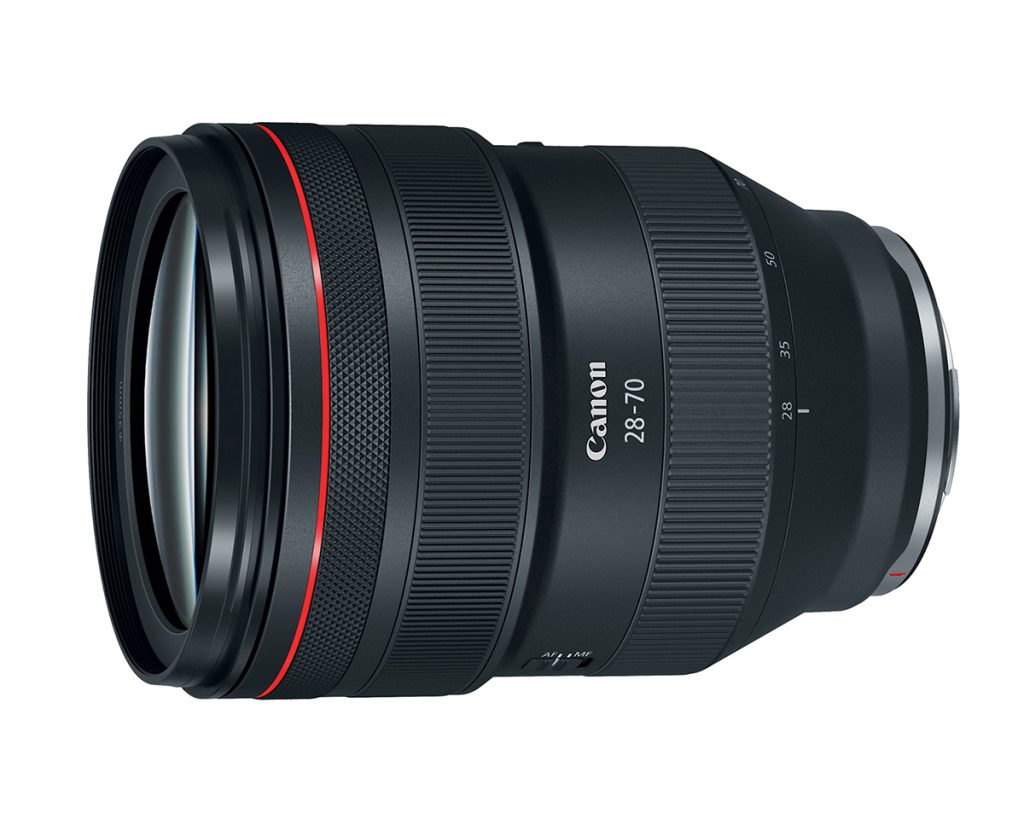


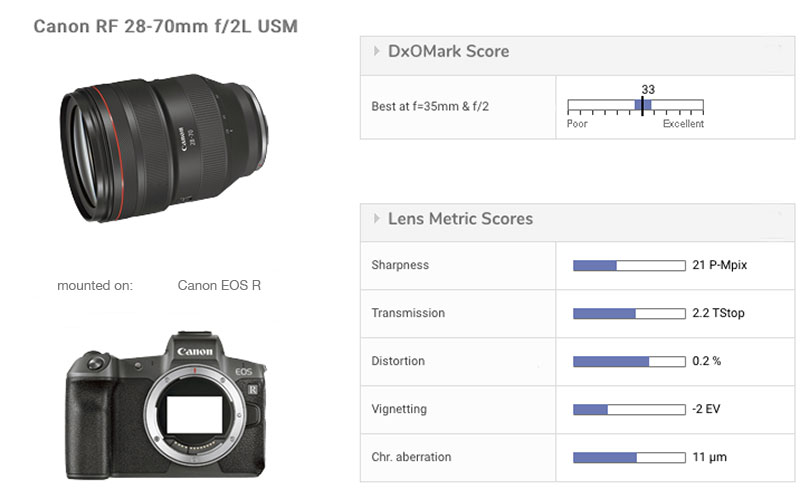
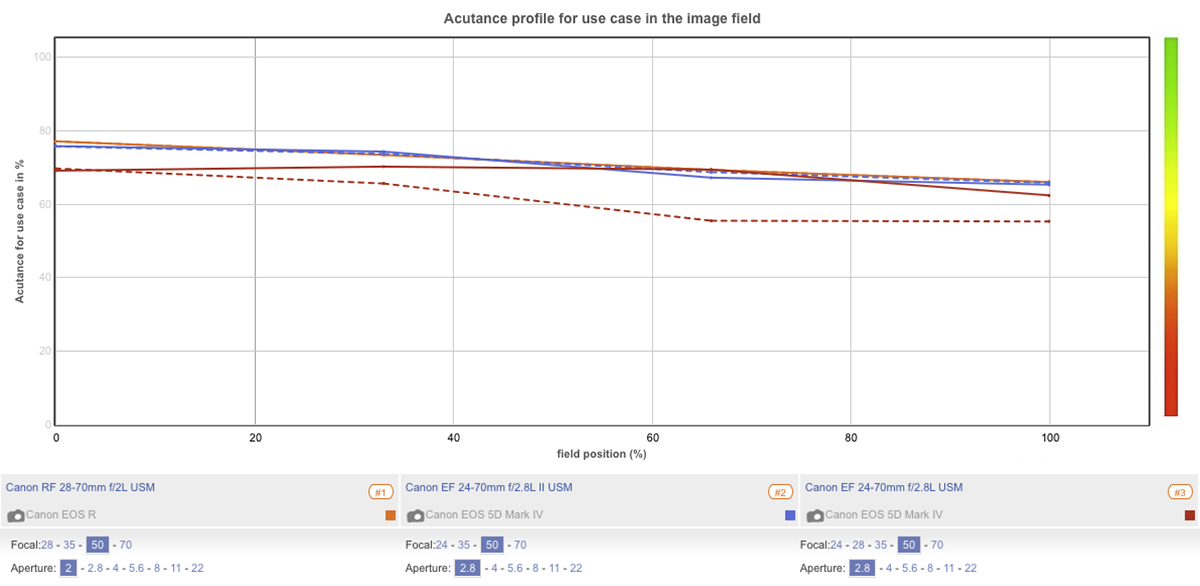
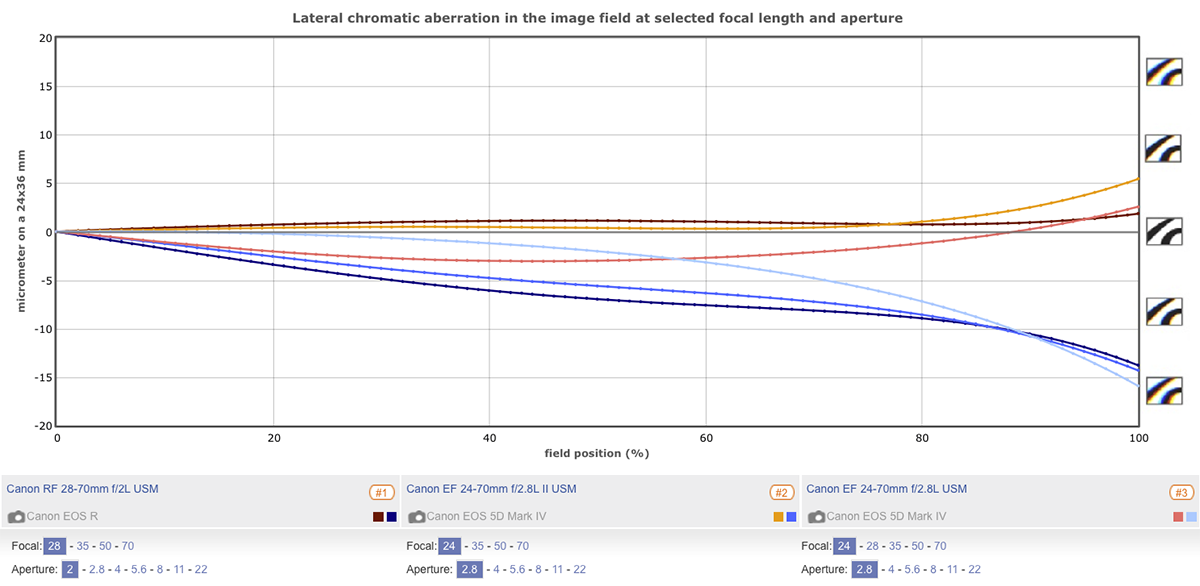
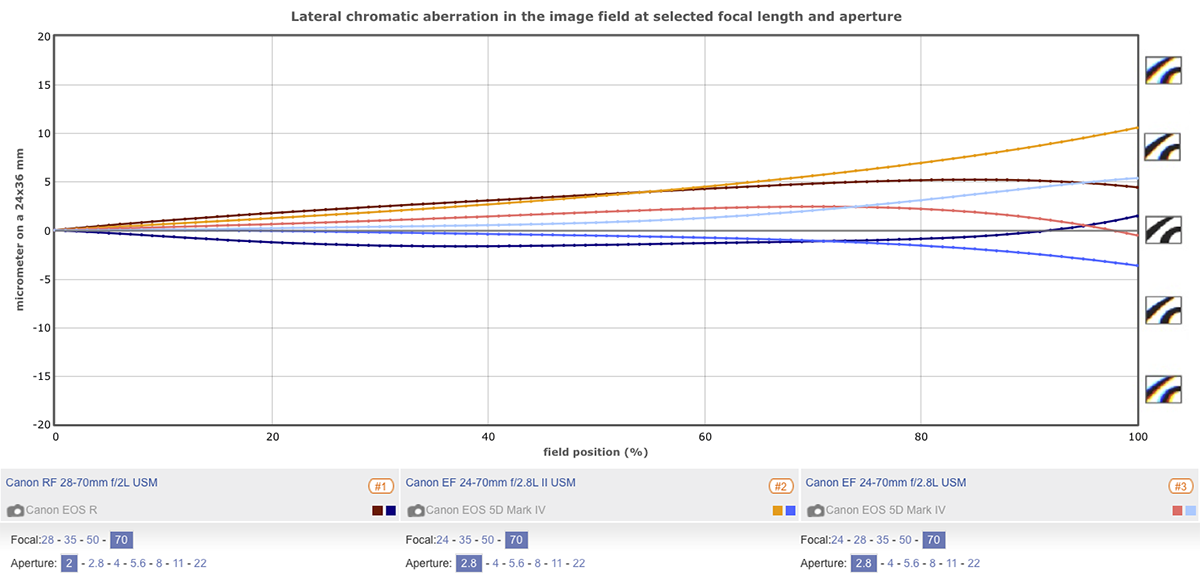
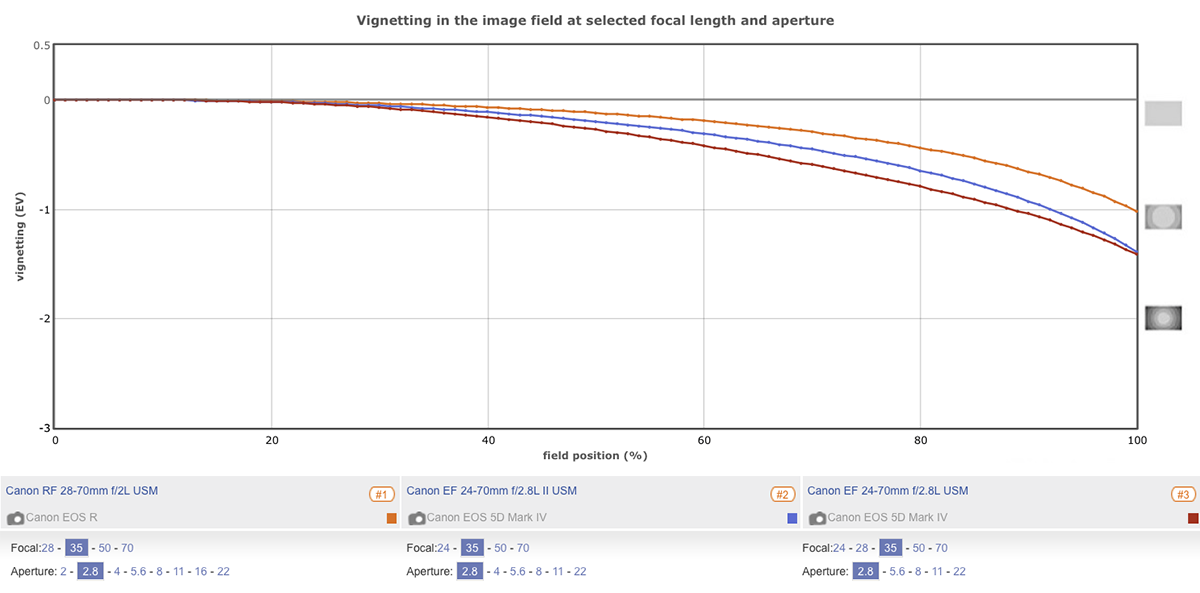
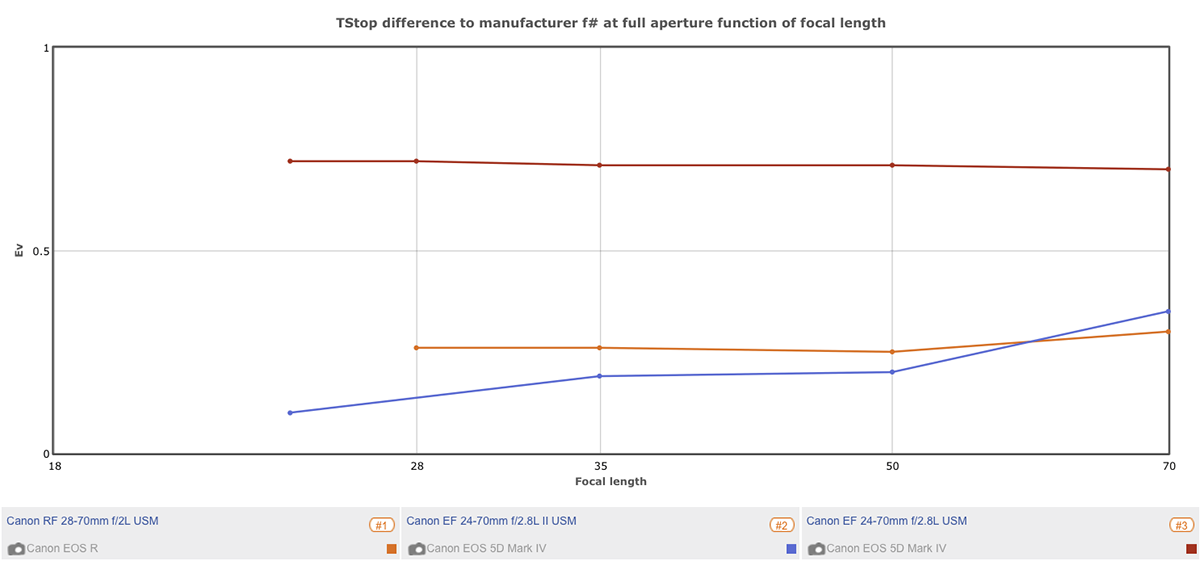


DXOMARK encourages its readers to share comments on the articles. To read or post comments, Disqus cookies are required. Change your Cookies Preferences and read more about our Comment Policy.